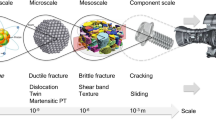Abstract
This paper concerns the lower of a range of thresholds that control the response of condensed matter under loading in compression, from the ambient laboratory state to the point at which the bond strength is overcome and warm dense matter is formed. One oft-used term is yield stress and its variation with the rise time of the loading pulse are considered in this first paper. This threshold shows a correlation between the length scale swept by the rise of the pulse and the defect distribution within the target for a range of materials. Strain rate is also a useful term that reflects the evolution of the stress state within a target but must be defined for a particular volume element containing a particular defect distribution to reflect continuum conditions acting within and thus applies to a defined length scale within a target. This overview of behavior suggests concepts borrowed from rate-independent plasticity have served the community well but that to advance it may be necessary to use viscoplastic concepts in constitutive descriptions for the future.




Similar content being viewed by others
References
Bourne, N.K.: Int. J. Imp. Engng., 2012. 48: p. 107-115.
Remington, B.A., P. Allen, E.M. Bringa, J. Hawreliak, D. Ho, K.T. Lorenz, H. Lorenzana, J.M. McNaney, M.A. Meyers, S.W. Pollaine, K. Rosolankova, B. Sadik, M.S. Schneider, D. Swift, J. Wark, and B. Yaakobi, Material dynamics under extreme conditions of pressure and strain rate. Materials Science and Technology, 2006. 22: p. 474-488.
Frenkel, J., Z. Phys., 1926. 37: p. 572.
Moriarty, J.A., L.X. Benedict, J.N. Glosli, R.Q. Hood, D.A. Orlikowski, M.V. Patel, P. Söderlind, F.H. Streitz, M. Tang, and L.H. Yang, Robust Quantum-Based Interatomic Potentials for Multiscale Modeling in Transition Metals. J. Mater. Res., 2006. 21: p. 563.
Pokluda, J., M. Cerny, P. Sandera, and M. Sob, Calculations of theoretical strength: State of the art and history. Journal of Computer-Aided Materials Design, 2004. 11: p. 1-28.
Vogler, T.J. and L.C. Chhabildas, Strength behavior of materials at high pressures. Int. J. Impact Engng, 2006. 33: p. 812-825.
Jeanloz, R., The nature of the Earth’s core. Ann. Rev. Earth Planet. Sci., 1990. 18: p. 357-386.
Karato, S.-i., Rheology of the Earth’s mantle: A historical review. Gondwana Research, 2010. 18(1): p. 17-45.
G.T. Gray III: in ASM Handbook. Vol. 8: Mechanical Testing and Evaluation, H. Kuhn and D. Medlin, Editors. 2000, ASM International: Materials Park, Ohio. p. 530-538.
Bourne, N.K., Materials in Mechanical Extremes: Fundamentals and Applications. 2013, Cambridge: Cambridge University Press.
N.K. Bourne: Metall. Mater. Trans. A, 2014, DOI:10.1007/s11661-014-2419-6.
Orowan, E., Z. Phys., 1934. 89: p. 634.
Orowan, E., Z. Phys., 1934. 89: p. 605.
Orowan, E., Z. Phys., 1934. 89: p. 614.
Orowan, E., Rep. Progr. Phys., 1949. 12: p. 185.
Hall, E.O., The Deformation and Ageing of Mild Steel: III Discussion of Results. Proc. Phys. Soc. London, 1951. 643: p. 747-753.
Petch, N.J., The Cleavage Strength of Polycrystals. J. Iron Steel Inst. London, 1953. 173: p. 25-28.
Armstrong, R.W. and S.M. Walley, High strain rate properties of metals and alloys. Int. Mater. Rev., 2008. 53: p. 105–128.
Follansbee, P.S., G. Regazzoni, and U.F. Kocks, The transition in drag-controlled deformation in copper at high strain rates. Inst. Phys. Conf. Ser., 1984. 70: p. 71–80.
Hoge, K.G. and A.K. Mukherjee, The temperature and strain rate dependence of the flow stress of tantalum. J. Mater. Sci., 1977. 12: p. 1666–1672.
Lankford, J., The role of dynamic material properties in the performance of ceramic armour. Int. J. Appl. Ceram. Technol., 2004. 1: p. 205-210.
Walley, S.M., J.E. Field, P.H. Pope, and N.A. Safford, A study of the rapid deformation behaviour of a range of polymers. Phil. Trans. R. Soc. Lond. A, 1989. 328: p. 1-33.
Armstrong, R.W., Bertram Hopkinson’s pioneering work and the dislocation mechanics of high rate deformations and mechanically induced detonations. Phil. Trans. R. Soc. A., 2014. 372: 20130181.
Bourne, N.K., Materials’ Physics in Extremes: Akrology. Metall. Trans. A., 2011. 42: p. 2975-2984.
Chen, M.W., J.W. McAuley, D.P. Dandekar, and N.K. Bourne, Dynamic plasticity and failure of high-purity alumina under shock loading. Nature Materials, 2006. 5: p. 814-818.
Bourne, N.K., J.C.F. Millett, M. Chen, D.P. Dandekar, and J.W. MacCauley, On the Hugoniot Elastic Limit in Polycrystalline Alumina. J. Appl. Phys., 2007. 102: 073514.
Whitley, V.H., S.D. McGrane, D.E. Eakins, C.A. Bolme, D.S. Moore, and J.F. Bingert, The elastic-plastic response of aluminum films to ultrafast laser-generated shocks. J. Appl. Phys., 2011. 109: 013505.
Winey, J.M., B.M. LaLone, P.B. Trivedi, and Y.M. Gupta, Elastic wave amplitudes in shock-compressed thin polycrystalline aluminum samples. J. Appl. Phys., 2009. 106: 073508.
Taylor, J.W. and M.H. Rice, Elastic-plastic properties of iron. J. Appl. Phys., 1963. 34: p. 364-371.
Bourne, N.K., G.T. Gray III, and J.C.F. Millett, On the shock response of cubic metals. J. Appl. Phys., 2009. 106: 091301.
N.K. Bourne, J.C.F. Millett, M.W. Chen, D.P. Dandekar, and J.W. McCauley: in Shock Compression of Condensed Matter, M.D. Furnish, et al., eds., American Institute of Physics, Melville, New York, 2007, pp. 739–42.
Millett, J.C.F., N.K. Bourne, and D.P. Dandekar, Delayed failure in shock-loaded silicon carbide. J. Appl. Phys., 2005. 97: 113513.
Murphy, W.J., A. Higginbotham, G. Kimminau, B. Barbrel, E.M. Bringa, J. Hawreliak, R. Kodama, M. Koenig, W. McBarron, M. Meyers, A, B. Nagler, N. Ozaki, N. Park, B. Remington, S. Rothman, S.M. Vinko, T. Whitcher, and J.S. Wark, The strength of single crystal copper under uniaxial shock compression at 100 GPa. J. Phys. Condens. Matter 2010. 22: 065404.
Acknowledgments
The author wishes to acknowledge comments of great incite from the referees who pointed out pitfalls in this view and expanded applications and future directions more completely than himself.
Author information
Authors and Affiliations
Corresponding author
Additional information
Manuscript submitted May 5, 2014.
Rights and permissions
About this article
Cite this article
Bourne, N.K. On Strength at Yield in Condensed Matter. Metall Mater Trans A 46, 4491–4497 (2015). https://doi.org/10.1007/s11661-014-2592-7
Published:
Issue Date:
DOI: https://doi.org/10.1007/s11661-014-2592-7



